The Not So Evil Underbelly of Discount & Coupon Marketing to Track Influencers, Personalize Pricing, Grow Sales & Beat Out the Competition
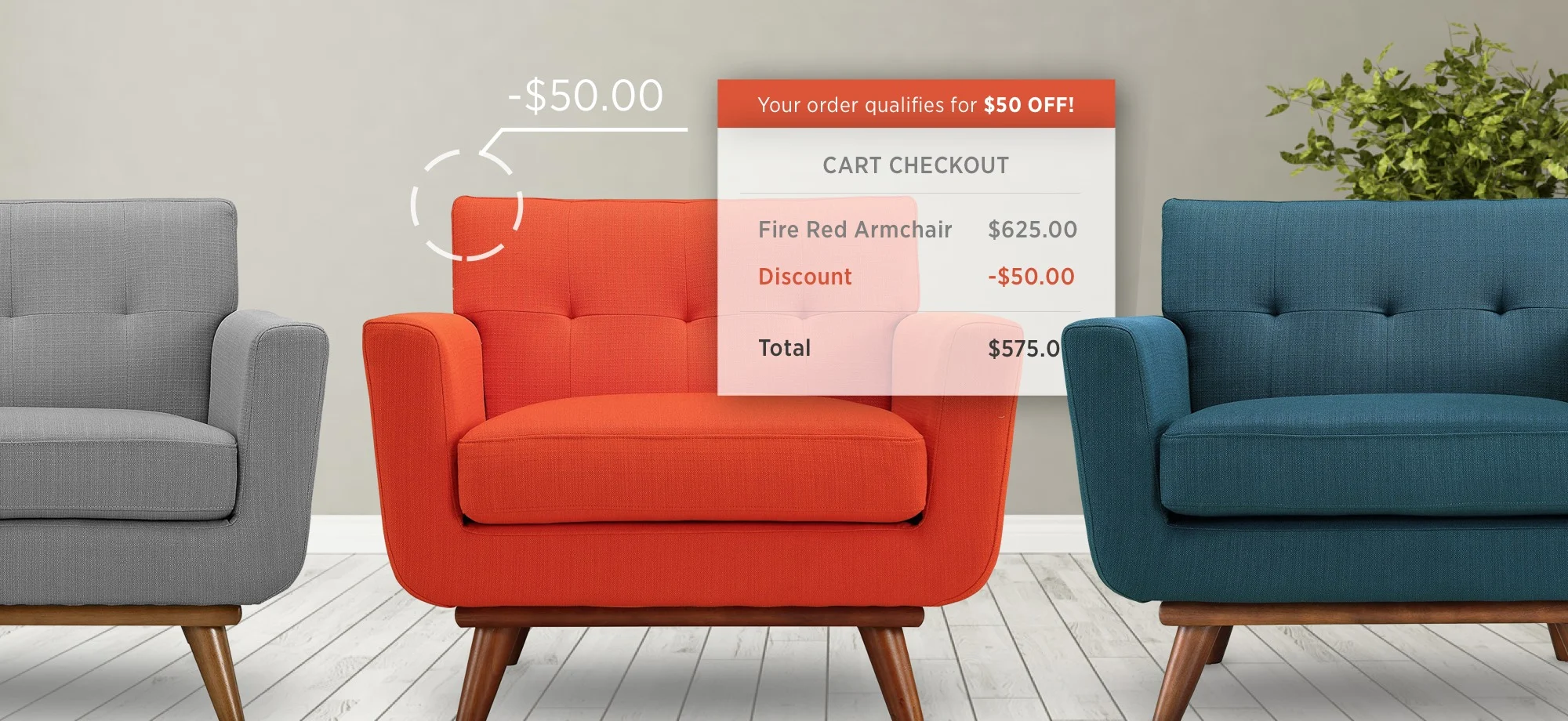
Promotions and discounts are serious business for online stores.
Whether you are need to launch a sudden Flash Sale due to an appearance on the Today Show (and thus earn a 50% conversion rate of 5,000 immediate visitors) or if you need to use specific discount codes for your affiliates and bloggers across the web to track the value of the relationship overtime based on discount usage –– every situation is unique, for every business, every single time.
Those two scenarios above are not just made up. This is how people do business. But along the way, there’s been a dirty little term used in the ecommerce industry that shies folks away from using discounts: pricing race to the bottom.
This term has long been something to avoid (and it still is). With Amazon’s low pricing, with which brands continue to find difficult to compete, the term came from the unprofitability and likely shuttering of any business that played in a pricing race to the bottom rather than building brand equity and finding full-price buyers.
This is true. You can’t discount everything.
But discounts aren’t the evil they’ve been made out to be.
In fact, folks just starting out to those pulling in $20,000,000 in revenue are using them consistently to measure influencer impact, personalize their sites, grow sales and ultimately make more money and win more mindshare than their competitor.
We’ll look at 4 of those brands here in just a moment. But first, it’s important that you understand this: discounts are part of your promotional marketing strategy.
And discounts have their own anatomy and hierarchy. If you’re going to sue them to drive growth, you need to understand what they are, how they stack and all of your options.
Let’s break it down.
A High-Level Anatomy of a Discount
A discount rule consists of some conditions and actions to apply. If all conditions are met, discounts are applied to the cart for a customer.
A discount rule can also show banners on the storefront to encourage customers on the site to use them.
These banners can show up on category specific pages, product specific pages, cart specific pages or the entire site.
Remember, these are all triggered by a rule outlining conditions to be met. Let’s spell that out a bit more:
Conditions: A condition evaluates properties of the cart or the line items in the cart. A discount rule can sometimes contain multiple conditions (see example below).
Actions: A discount can be a fixed discount, percentage discount, *free product or free shipping. Discounts can be applied to the cart or individual line items. You should be able to set the execution sequence/priority of marketing discount rules. Discounts are always applied to the base price and they always stack on top of other discounts unless there is a halt enabled (which will be explained more in a moment). Most discounts only apply at a product-level, not a Product Option / Product SKU-level.
Banners: A discount rule can have banners that are shown on the cart page. The discount rule defines when a banner is shown and what is shown. Banners usually contain information about the discounts applied (congratulations banner) or discounts that could be applied (eligibility banner) or a combination of both.

Cool –– everyone still with me? Now, to set up an effective discount, you need to consider how it individually scales, tiers, how it halts and how it interrelates with other discount rules.
Here is how that breaks down:
Scaling: The wording on a condition indicates if a discount rule scales or not. For example:
Buy 1 or more Stripe Pants get $10 off 1 American Towel
Buy 1 Stripe Pants get $10 off 1 American Towel
In the first example, no matter how many Stripe Pants you buy, the customer will always receive only 1 discount. Whereas in the second example, your customer will receive multiple discounts depending on how many Stripe Pants they buy, i.e. the multiple effect. For example, if they purchased 3 Stripe Pants, you would receive $30 off 1 American Towel.
Tiering: Tiering refers to a store owner’s ability to define different discounts depending on how much a customer spends or how many units they purchase. For example:
Spend $100, get 10% off.
Spend $150 get, 15% off.
Spend $200, get 20% off.
Buy 2 units, get $10 off.
Buy 3 units, get $15 off.
Buy 4 units, get $20 off.
Halting: You should be able to set a halt condition on discount rules –– that is, if various discounts are stacked, you can implement a halt rule to stop the continued staked discounting once a set limit is reached. If a discount rule has a halt condition enabled, it should only halt if it has applied a discount.
Interrelating: This is when you set an execution order (or priority) in which the discount rules trigger. As such, when designing discount rules, you need take into consideration how multiple discounts can compound together to affect the price of a single product –– and which receive higher priority for your brand and goals.
All right –– now that you have your strategy in place, it’s time to actually build the discount. To do that, you want to make sure you can name it effectively, schedule it effectively (to save you time and hassle), apply it to particular groups as necessary and more.
Here are the top things to think through as you setup each individual discount.
General details: You’ll need to name the discount rule and give it a description. This is for internal use only.
Scheduling: Set the life/duration of the discount by date/time. You can configure the Start Date, Start Time, End Date, End Time for any discount rules. These should all operate off the store timezone you’ve specified.
Customer group targeting: Want only your VIP or wholesale customers to see specific discounts? Cool, ensure that these discounts only apply to specific Customer Groups. The shopper will only experience this discount if they have logged into their account on the storefront.
Usage: Limit the number of times a discount is used. If you set the limit to 100, for instance, you are saying that the discount an only be used a total of 100 times across all shoppers on the storefront.
Activate: You don’t have to create and then delete your discounts when you are finished with them. If one worked really well, just hide it from view of customers and turn it back on when needed. You can also use this to hide discounts from customers but still allow affiliates to post the code to use back on your site.
Application: Will you choose to apply the discount t the product/item-level, the order subtotal/cart-level or the shipping cost? Here is how those break out:
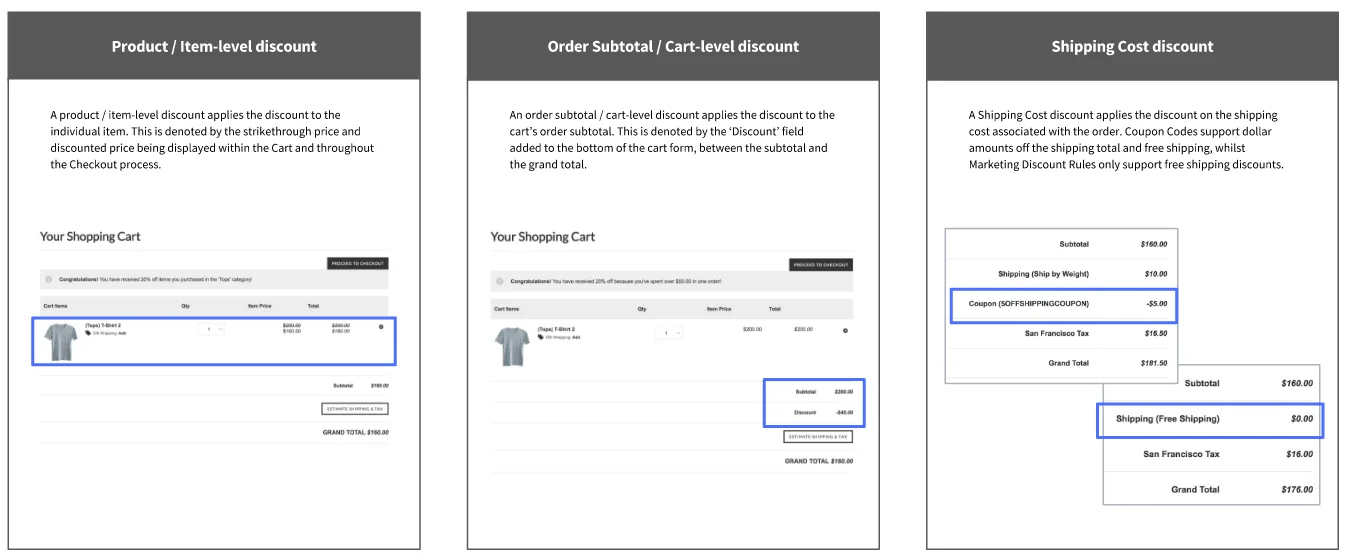
Depending on the platform you are selling on, you have various access to discount and coupon codes. On BigCommerce, merchants have 72 different options out of the box to implement.
Let’s look at how 4 merchants are doing just that.
Track Influencer Impact with Your Coupon Code Strategy
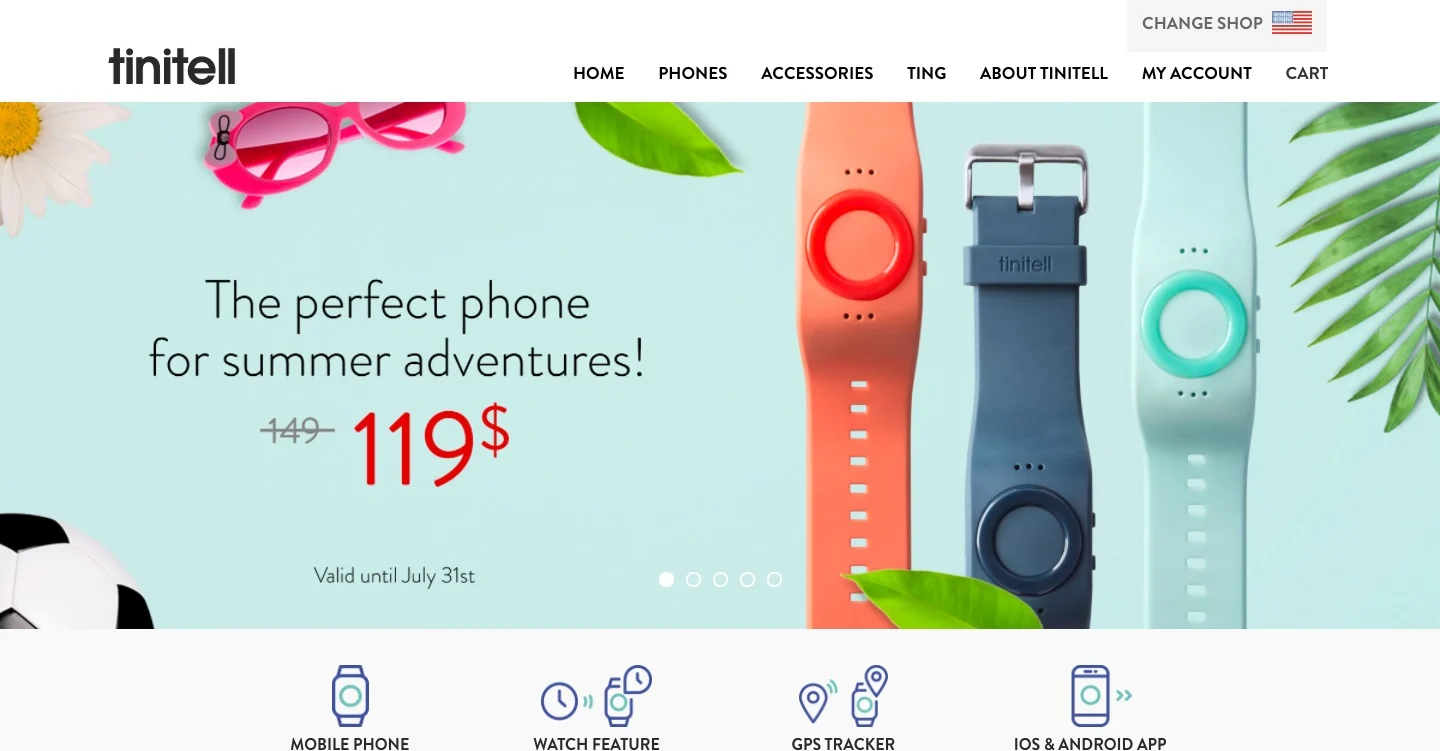
Tinitell works extensively with influencers and bloggers to get their product in front of the moms of the world. They have localized sites in the US and the EU to optimize each site for the specific region and style of partnering –– as well as to make the shipping experience as quick and easy as possible.
From the outside looking in, you’d think Tinitell was a multi-million dollar, hundred-plus person brand –– not the lean startup it really is.
In their world, every employee wears various hats –– and as much of the work as possible is handed off to outside resources.
I’m not talking about freelancers or agencies, though. Tinitell has a worked to build a community of mommy bloggers who drive traffic back to their site based on promotions and discounts specific to each blogger.
This means they have thousands of discounts and coupon codes loaded up into the system.
The reason for this, though, is tracking and measurement. Individual discount codes can be used overtime and helps the brand track which mommy bloggers drive the most revenue over the long haul –– which helps the team understand where to spend their time to get the most value.

A high-performing coupon code with 48 uses.
“Whenever we send our influencers, instagrammers and bloggers a unit to review or to take a photo, we also give them a discount code for their audience,” says Mihaela Novac, CMO at Tinitell. “This is so that we understand exactly how much we’ve spent on the original investment to send a free product.”
You might think that the Tinitell team could use affiliate links, UTMs or Google Analytics to make this work without the need for specific codes, but Mihaela disagrees. When you are working to convince parents to buy a new item, specifically mothers, for their children, the buyer’s journey is long and convoluted. It’s hard to track first or last touch –– or what finally made someone convert.
But with a discount code, the specific code someone finds and uses helps point the Tinitell team toward which blogs and influencers have the most impact.
“For selling to moms, they aren’t just getting on our website, seeing the Tinitell, liking it and then buying it. No,” says Mihaela. “They are seeing the ad, then accessing the website. They then go and read everything on Google and look for reviews. And then she’s gone for 2-3 days, just back in her busy life, until she checks it out again on her phone. Later she gets her partner to look at it, too. By now, it’s been 2 to 3 weeks –– I’m ready to purchase. I go back to that ad that had that coupon, or Google for another one, which has SEO implications for our bloggers.”
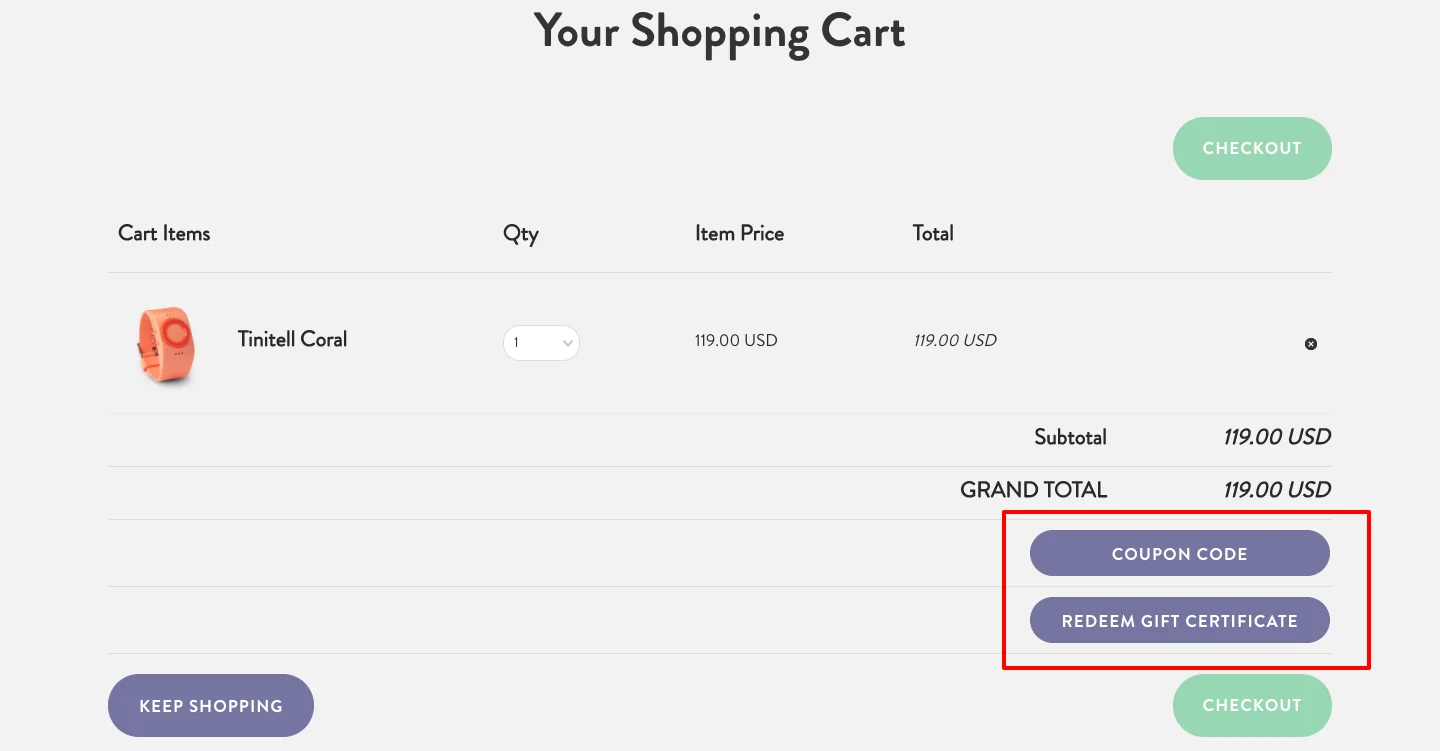
Now, to make this work, the lean Tinitell team needs to be able to bulk upload discount codes and manage their effectiveness.
“When we moved to BigCommerce, we had around 3,000 individual codes to put in the system and we found the bulk solution to do it perfectly well,” says Mihaela.
But it isn’t just affiliates and influencers that get discount codes from Tinitell. The brand also runs reward programs and contests on social and around the web –– and uses gift certificates to give those winners free products.
“For us, we have to have gift certificates in the shop. That was something we needed out of the box. Otherwise, these winners wouldn’t buy a thing and you can’t use discounts to get to $0,” says Mihaela. “Having these gift certificates makes it super easy, and it was something Shopify just couldn’t do.”
Drive Conversion with Unique Ecommerce Promotion Ideas
You can find Kurgo products in 98% of pet stores across the U.S. –– as well as marketplaces like Amazon. With so much brand visibility and profits coming in from third-party channels, the Kurgo website team is tasked with giving customers a reason to buy from the site rather than elsewhere.
At the end of the day, a buy on the site earns Kurgo an email address to build their addressable list and build lifetime value over time. With an active fan base on social –– many of the folks there people who have bought on Amazon or in-store –– the Kurgo team uses discounts and promotions to drive fans back to the site for impulse purchases.
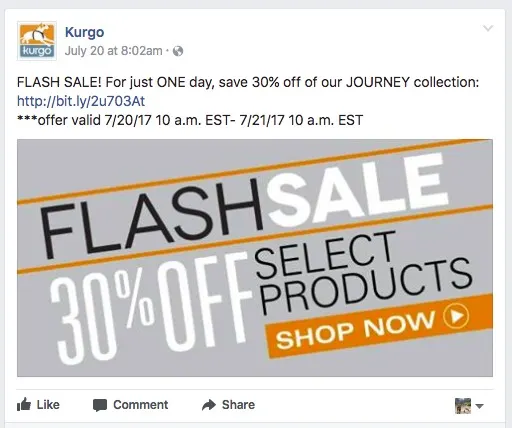
“We have a decent number of promotions to be honest,” says Andie Missert, Ecommerce Marketing Specialist at Kurgo. “We usually have about one a month, and sometimes we’ll have a universal sale across our whole site. Something like a 20% off across the board.”
But what’s really been working well for the team are cart level discounts.

Cart-level discount builder tool in BigCommerce.
“We’ve also been experimenting with different kinds of cart levels discounts,” says Andie. “Last holiday, we did a ‘buy two toys and get one free’. More recently, we did a deal that was if you buy a certain leash, you get a collar free. That one actually did really, really well!”
Ultimately, that last discount, drove 63 conversions in 7 days for the brand.
“There certainly are other outlets online and in brick and mortar stores for people to find our products and purchase them,” says Andie. By running certain promotions on our website that are unique, great deals, we’re hoping that people will purchase on our site, too. And it’s working.”
“Plus, it’s very, very simple to create different kinds of promotions that we can test and see what works best with our email subscribers and our site visitors. It seems like there are just so many options of different things that we can do!”
Increase Sales from Abandoned Cart with 5% Off Coupons
With a background in marketing and SEM, Grant Yuan was convinced that discounting online only cut into margins, at nor actual profit for online brands. So, 3 years ago, when he started CuttingBoard.com, he was determined not to use a single one.
“I come from a background where discounting is almost a bit of an evil word. People would say, ‘Oh, you don’t want those discounters coming to your website.’ They say it creates an expectation, I do find that is true. But ultimately, the internet is a democratic place where price matters and easy to compare.”
Grant didn’t come to this conclusion easily –– or without proof.
But when his checkout discount codes started to increased conversion 5%, and then 10%, with only 5% or 10% discounts, he knew he was on to something.
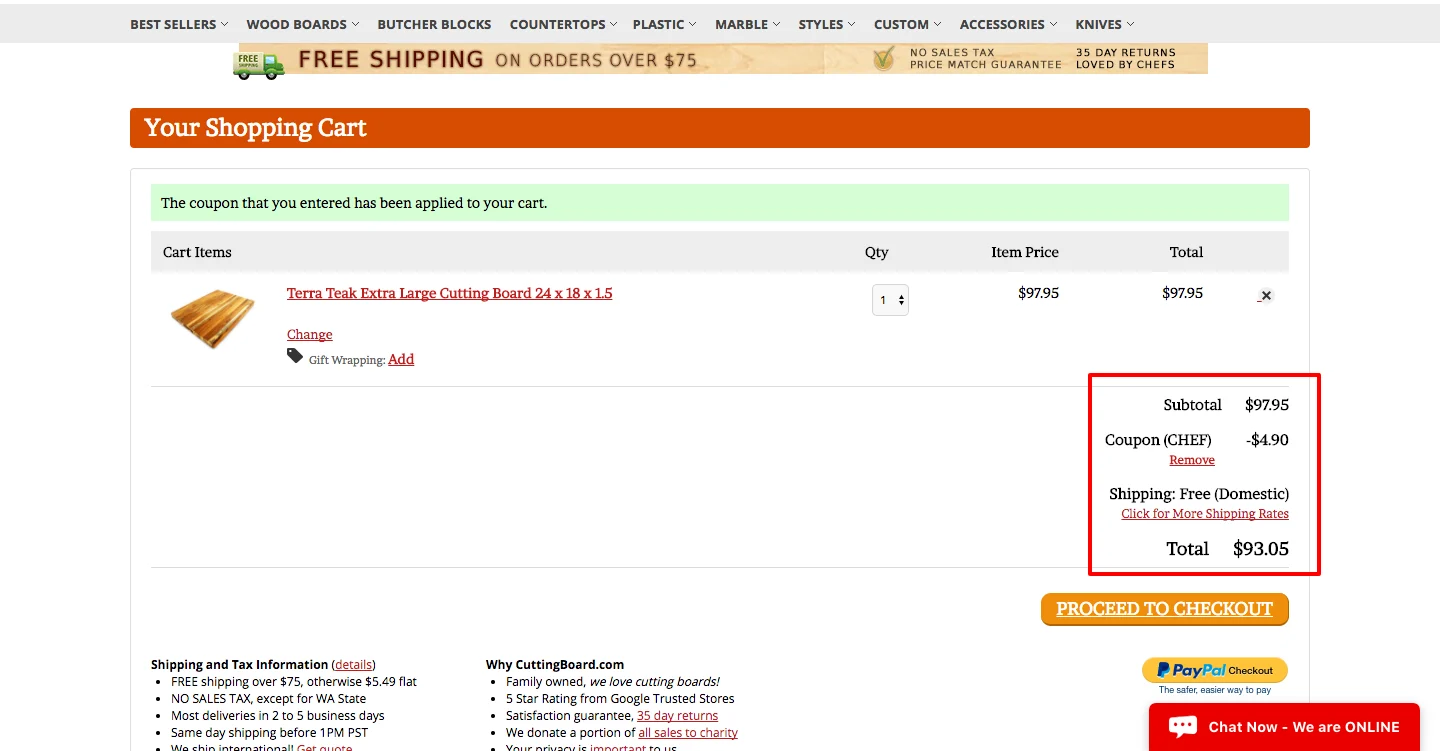
“It was really when I started putting the discount codes into the abandoned cart that I realized how well this works. People are coming back and buying more than ever –– and they are using that coupon.”
The side effect to running a lot of promotional programs is that –– yes –– you may set an expectation with the consumer. To battle that, Grant creates a discount calendar to make sure he is never overlapping or over-promoing.
“Part of my life now is keeping track of when we’re running promotions and when we’re not,” says Grant. “I tend to remember all the major holidays now because I look for every reason to give a small time discount!”
Discount Your Way to $1M+ in Revenue
If you’ve read any of my other articles, you know I interview a lot of people. How I find and choose those people varies, but when it came to Expression Fiber Arts, it was an email from a freelancer.
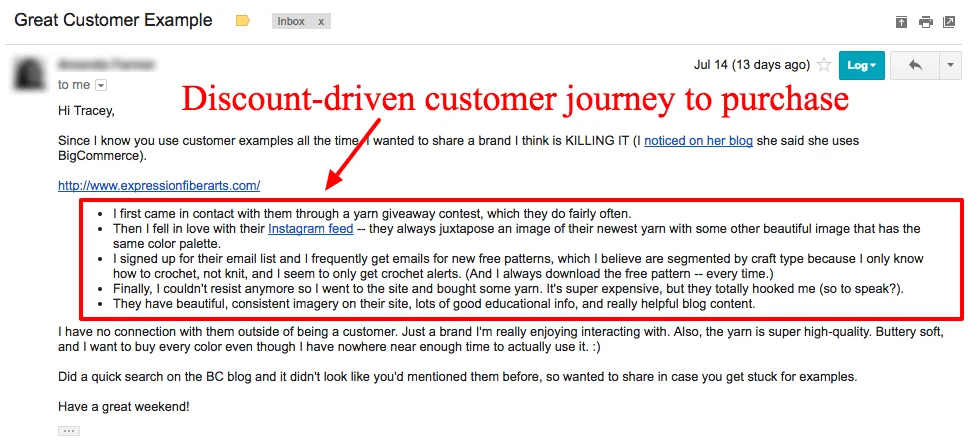
I had to reach out. That customer journey description was just too good. It was clear that Chandi, the founder of Expression Fiber Arts, was doing one of the most important things in ecommerce better than so many: providing upfront value.
And, it was working.
Indeed, Chandi uses promotions and coupons on Facebook, Instagram and her own website. She launches monthly giveaways and offers downloadables –– for free. She does everything you could possibly think of to help her audience knit better, higher quality goods.
And she gives almost all of it away for absolutely nothing.
“I don’t like to just ask people to come buy from us, because they don’t know us yet. Instead, we give away a lot of free patterns,” says Chandi. “We do huge yarn giveaways, like $1,000 yarn giveaways every month. I do a lot of Facebook ads to get people to come over and get the free stuff. Then, if they want to buy stuff later, they can. They don’t have to. But, that’s how we do it. We show them who we are. Give them some free stuff. Ask them to mingle more and hangout. But there’s no pressure.”
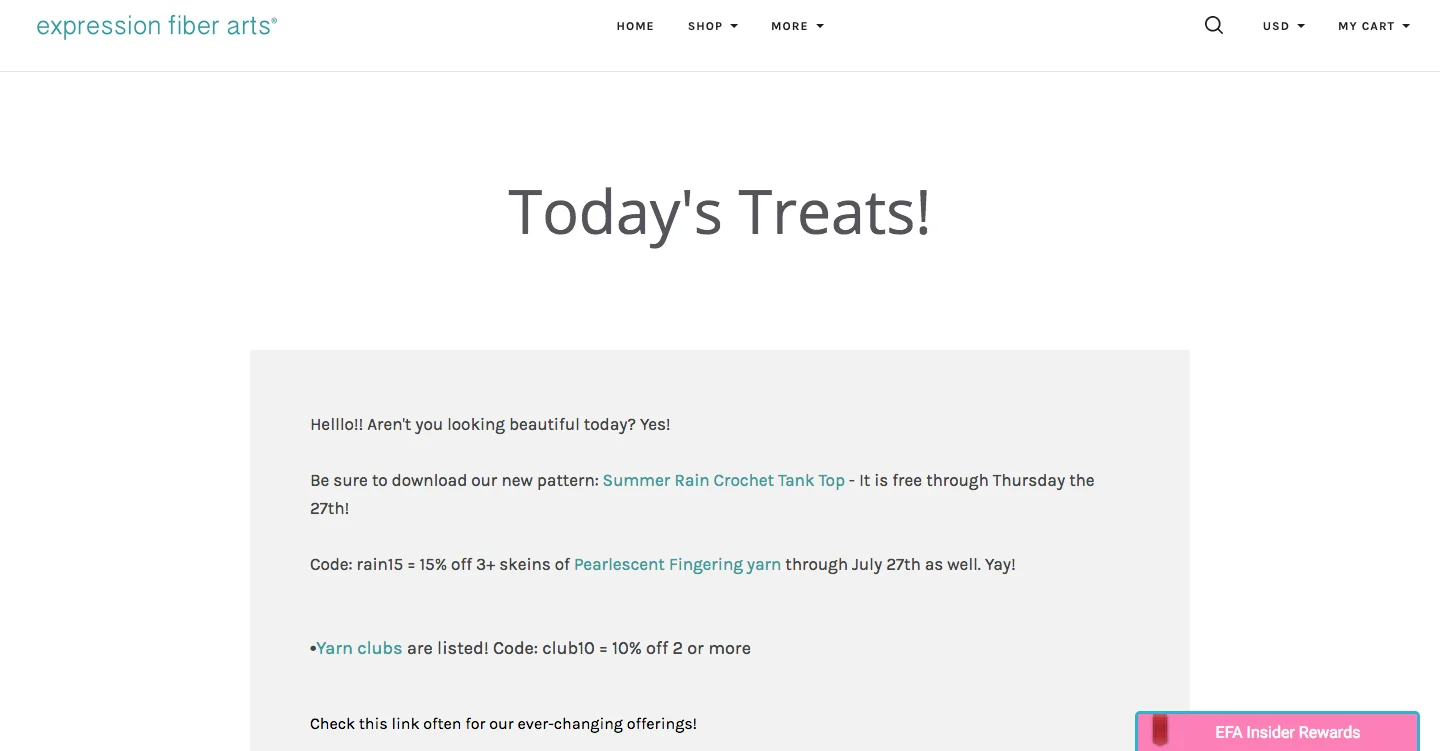
This has won her a massive online following. It’s also earned her a 20% YoY growth in the 7-figure range.
“Every week, we feature a different category, like a different type of yarn. Then, we tell the audience that we have a new free pattern for them, and give them a coupon for the specific yarn that goes with that pattern,” says Chandi. “We also have monthly yarn clubs, and part of that club is that you get a special coupon that no one else has. I just want people to be able to get get awesome deals.”
How Ecommerce Promotions Can Serve Your Business
No matter your ecommerce promotion strategy, it is essential that you have the discount tool you need to offer the deals that work best for your brand at scale. Be sure to think through your discount and coupon marketing strategy for the entire year to help boost sales, drive up your addressable email list and ultimately grow your business.
Learn More About BigCommerce’s Discounts + Coupons
With more than 72 discounts and coupons available out the box, BigCommerce is next to none if offering you the customizations you need to win hearts and minds and grow your brand’s community.

Tracey is the Director of Marketing at MarketerHire, the marketplace for fast-growth B2B and DTC brands looking for high-quality, pre-vetted freelance marketing talent. She is also the founder of Doris Sleep and was previously the Head of Marketing at Eterneva, both fast-growth DTC brands marketplaces like MarketerHire aim to help. Before that, she was the Global Editor-in-Chief at BigCommerce, where she launched the company’s first online conference (pre-pandemic, nonetheless!), wrote books on How to Sell on Amazon, and worked closely with both ecommerce entrepreneurs and executives at Fortune 1,000 companies to help them scale strategically and profitably. She is a fifth generation Texan, the granddaughter of a depression-era baby turned WWII fighter jet pilot turned self-made millionaire, and wifed up to the truest of heroes, a pediatric trauma nurse, who keeps any of Tracey’s own complaints about business, marketing, or just a seemingly lousy day in perspective.


